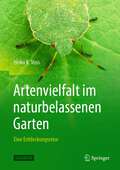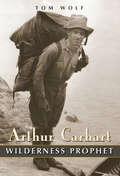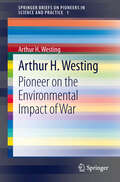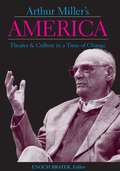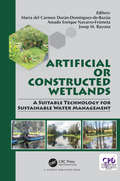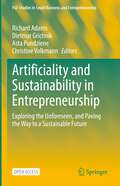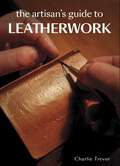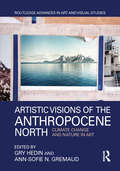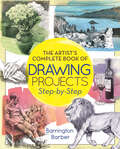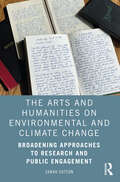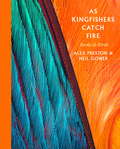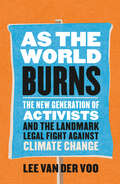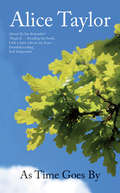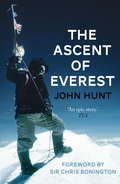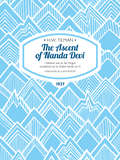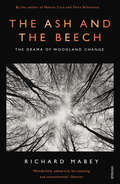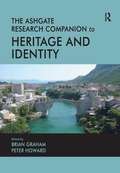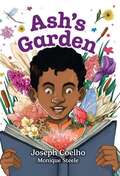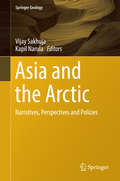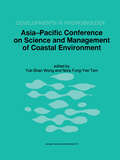- Table View
- List View
Artenvielfalt im naturbelassenen Garten: Eine Entdeckungsreise
by Heiko K. VossDieses Buch nimmt Sie mit auf eine Gartenerkundung der besonderen Art: In außergewöhnlichen Fotos und persönlichen Texten berichtet der Autor von staunenswerten Entdeckungen in Flora und Fauna, die er in seinem naturbelassenen Garten macht. Durch enthaltsames Gärtnern hat sich dort nach nur wenigen Jahren eine beeindruckende Biodiversität eingestellt, welche der Autor durch die Jahreszeiten hindurch dokumentiert. Ein Gartenrundgang auf Du und Du mit der Natur, der die Augen öffnet für eine wundersame Welt im Kleinen und Lust macht, im eigenen Garten Lebensräume für die Tierwelt zu gestalten!
Arthur Carhart: Wilderness Prophet
by Tom WolfArthur Carhart (1892 -1978), America's first champion of wilderness, the first Forest Service landscape architect, and the most popular conservation writer of mid-century America, won none of the titan status of his contemporary Aldo Leopold. A political maverick, he refused to side with any major advocacy group and none has made him its saint. Carhart was a grassroots thinker in a top-down era. Arthur Carhart, the first biography of this Republican environmentalist and major American thinker, writer, and activist, reveals the currency of his ideas. Tom Wolf elucidates Carhart 's vision of conservation as "a job for all of us," with citizens, municipal authorities, and national leaders all responsible for the environmental effects of their decisions. Carhart loved the local and decried interest groups - from stockmens' associations to wilderness lobbies - as cliques attempting blanket control. He pressured land management agencies to base decisions on local ecology and local partnerships. A lifelong wilderness advocate who proposed the first wilderness preserve at Trappers Lake, Colorado, in 1919, Carhart chose to oppose the Wilderness Act, heartsick at its compromises with lobbies. Because he shifted his stance and changed his views in response to new information, Carhart is not an easy subject for a biography. Wolf traces Carhart's twists and turns to show a man whose voice was distinctive and contrary, who spoke from a passionate concern for the land and couldn't be counted on for anything else. Readers of American history and outdoor writing will enjoy this portrait of a historic era in conservation politics and the man who so often eschewed politics in favor of the land and people he loved.
Arthur H. Westing: Pioneer on the Environmental Impact of War (SpringerBriefs on Pioneers in Science and Practice #1)
by Arthur H. WestingSince the 1960s the environment has become an issue of increasing public concern in North America and elsewhere. Triggered by the Second Indochina War (Vietnam Conflict) of 1961-1975, and further encouraged by the International Conference on the Human Environment, held in Stockholm in 1972, the environmental impact of war emerged and grew as a topic of research in the natural and the social sciences. And in the late 1980s this led additionally to a focus and debate on environmental security. Arthur Westing, a forest ecologist, was a major pioneer contributing and framing both of those debates conceptually, theoretically, and empirically, starting with Harvest of Death: Chemical Warfare in Vietnam and Cambodia (1972) (co-authored with wildlife biologist E.W. Pfeiffer and others). As a Senior Researcher at the Stockholm and Oslo International Peace Research Institutes (SIPRI and PRIO), and as a Professor of Ecology at Windham and Hampshire Colleges, Westing authored and edited books on Ecological Consequences of the Second Indochina War (1976), Weapons of Mass Destruction and the Environment (1977), Warfare in a Fragile World: Military Impact on the Human Environment (1980), Herbicides in War: the Long-term Ecological and Human Consequences (1984), Environmental Warfare: a Technical, Legal and Policy Appraisal (1984), Explosive Remnants of War: Mitigating the Environmental Effects (1985), Global Resources and International Conflict: Environmental Factors in Strategic Policy and Action (1986), Cultural Norms, War and the Environment (1988), Comprehensive Security for the Baltic: an Environmental Approach (1989), and Environmental Hazards of War: Releasing Dangerous Forces in an Industrialized World (1990) --- as well as authoring numerous UN reports, book chapters, and journal articles. This volume combines six of his pioneering contributions on the environmental consequences of warfare in Viet Nam and in Kuwait, on the environmental impact of nuclear war, and on legal constraints and military guidelines for protecting the environment in wartime
Arthur Miller's America: Theater and Culture in a Time of Change (Theater: Theory/Text/Performance)
by Enoch BraterPerspectives on America's greatest living playwright that explore his longstanding commitment to forging a uniquely American theater Arthur Miller's America collects new writing by leading international critics and scholars that considers the dramatic world of icon, activist, and playwright Arthur Miller's theater as it reflects the changing moral equations of his time. Written on the occasion of Miller's 85th year, the original essays and interviews in Arthur Miller's America treat the breadth of Miller's work, including his early political writings for the campus newspaper at the University of Michigan, his famous work with John Huston, Clark Gable and Marilyn Monroe on The Misfits, and his signature plays like Death of a Salesman and All My Sons.
Artificial or Constructed Wetlands: A Suitable Technology for Sustainable Water Management
by María-Del-Carmen Durán-Domínguez-De-Bazua Amado Enrique Navarro-Ómeta Josep M. BayonaArtificial or constructed wetlands are an emerging technology particularly for tropical areas with water scarcity. For big cities, the sustainable management of water resources taking into account proper use is always challenging. The book presents case studies illustrating the above. As plants and microorganisms are a fundamental part of the correct functioning of these systems, their contribution to the degradation of the organic matter and to the removal and transformation of the pollutant compounds present in the wastewaters is also a highlight of this book.
Artificial or Constructed Wetlands: A Suitable Technology for Sustainable Water Management
by María del Carmen Durán-Domínguez-de-Bazúa Amado Enrique Navarro-Frómeta Josep M. BayonaArtificial or constructed wetlands are an emerging technology particularly for tropical areas with water scarcity. For big cities, the sustainable management of water resources taking into account proper use is always challenging. The book presents case studies illustrating the above. As plants and microorganisms are a fundamental part of the correct functioning of these systems, their contribution to the degradation of the organic matter and to the removal and transformation of the pollutant compounds present in the wastewaters is also a highlight of this book.
Artificiality and Sustainability in Entrepreneurship: Exploring the Unforeseen, and Paving the Way to a Sustainable Future (FGF Studies in Small Business and Entrepreneurship)
by Richard Adams Dietmar Grichnik Asta Pundziene Christine VolkmannThis open access edited volume explores the past, present, and future of artificiality and sustainability in entrepreneurship – the unforeseen consequences and ways to advance to a sustainable future. In particular, it connects artificiality, sustainability and entrepreneurship, intertwining artificial with the specific phenomenon of those novel digital technologies that provoke continuous and significant change in our lives and business. Unlike digital entrepreneurship research, which focuses on digital technology development and management, this book covers processes and mechanisms of sustainable adaptability of entrepreneurs, the business logic of start-ups, and the collaborative behaviours under the mass digital transformation, including the prevalence of artificial intelligence. Some of the questions that this book answers are as follows: How has entrepreneurship reacted to such challenges previously? What lessons have been learned and need to be carried forward? How can entrepreneurship and the artefacts of entrepreneurship respond to current challenges? What should be the mindset of the entrepreneur to assure sustainable adaptation? How to embrace and embed the new business logic?
Artistic Visions of the Anthropocene North: Climate Change and Nature in Art (Routledge Advances in Art and Visual Studies)
by Gry Hedin Ann-Sofie N. GremaudIn the era of the Anthropocene, artists and scientists are facing a new paradigm in their attempts to represent nature. Seven chapters, which focus on art from 1780 to the present that engages with Nordic landscapes, argue that a number of artists in this period work in the intersection between art, science, and media technologies to examine the human impact on these landscapes and question the blurred boundaries between nature and the human. Canadian artists such as Lawren Harris and Geronimo Inutiq are considered alongside artists from Scandinavia and Iceland such as J.C. Dahl, Eija-Liisa Ahtila, Toril Johannessen, and Björk.
Artistic Visions of the Anthropocene North: Climate Change and Nature in Art (Routledge Advances in Art and Visual Studies)
by Gry Hedin Ann-Sofie N. GremaudIn the era of the Anthropocene, artists and scientists are facing a new paradigm in their attempts to represent nature. Seven chapters, which focus on art from 1780 to the present that engages with Nordic landscapes, argue that a number of artists in this period work in the intersection between art, science, and media technologies to examine the human impact on these landscapes and question the blurred boundaries between nature and the human. Canadian artists such as Lawren Harris and Geronimo Inutiq are considered alongside artists from Scandinavia and Iceland such as J.C. Dahl, Eija-Liisa Ahtila, Toril Johannessen, and Björk.
The Artist's Complete Book of Drawing Projects Step-by-Step
by Barrington BarberWhen it comes to drawing there is no substitute for practice, and with this collection of 100 drawing projects you'll never be short of inspiration. From capturing the play of light in a sparkling water glass to composing a family portrait, there is a wide range of subject matter to develop your skills. Each drawing is broken down into five easy steps, so you can see exactly how tone is applied at every stage. Whether you are budding artist or a professional wishing to hone their skills, Barrington Barber's accessible teaching style makes this a must-have manual for those looking to improve their drawing using a relaxed but effective method.
The Arts and Humanities on Environmental and Climate Change: Broadening Approaches to Research and Public Engagement
by Sarah SuttonThe Arts and Humanities on Environmental and Climate Change examines how cultural institutions and their collections can support a goal shared with the scientific community: creating a climate-literate public that engages with environmental issues and climate change in an informed way. When researchers, curators, and educators use the arts and humanities to frame discussions about environmental and climate change, they can engage a far wider public in learning, conversation, and action than science can alone. Demonstrating that archival and object-based resources can act as vital evidence for change, Sutton shows how the historical record, paired with contemporary reality, can create more personal connections to what many consider a remote experience: the changing climate. Providing valuable examples of museum collections used in discussions of environmental and climate change, the book shares how historic images and landscape paintings demonstrate change over time; and how documentary evidence in the form of archaeological reports, ships logs, Henry David Thoreau’s journals, and local reports of pond hockey conditions are being used to render climate data more accessible. Images, personal records, and professional documents have critical roles as boundary objects and proxy data. These climate resources, Sutton argues, are valuable because they make climate change personal and attract a public less interested in a scientific approach. This approach is underused by museums and their research allies for public engagement and for building institutional relevancy. The Arts and Humanities on Environmental and Climate Change will be most interesting to readers looking for ways to broaden engagement with environmental and climate issues. The ideas shared here should also act as inspiration for a broad spectrum of practitioners, particularly those writing, designing, and curating public engagement materials in museums, for wider research, and for the media.
The Arts and Humanities on Environmental and Climate Change: Broadening Approaches to Research and Public Engagement
by Sarah SuttonThe Arts and Humanities on Environmental and Climate Change examines how cultural institutions and their collections can support a goal shared with the scientific community: creating a climate-literate public that engages with environmental issues and climate change in an informed way. When researchers, curators, and educators use the arts and humanities to frame discussions about environmental and climate change, they can engage a far wider public in learning, conversation, and action than science can alone. Demonstrating that archival and object-based resources can act as vital evidence for change, Sutton shows how the historical record, paired with contemporary reality, can create more personal connections to what many consider a remote experience: the changing climate. Providing valuable examples of museum collections used in discussions of environmental and climate change, the book shares how historic images and landscape paintings demonstrate change over time; and how documentary evidence in the form of archaeological reports, ships logs, Henry David Thoreau’s journals, and local reports of pond hockey conditions are being used to render climate data more accessible. Images, personal records, and professional documents have critical roles as boundary objects and proxy data. These climate resources, Sutton argues, are valuable because they make climate change personal and attract a public less interested in a scientific approach. This approach is underused by museums and their research allies for public engagement and for building institutional relevancy. The Arts and Humanities on Environmental and Climate Change will be most interesting to readers looking for ways to broaden engagement with environmental and climate issues. The ideas shared here should also act as inspiration for a broad spectrum of practitioners, particularly those writing, designing, and curating public engagement materials in museums, for wider research, and for the media.
As Kingfishers Catch Fire: Birds & Books
by Neil Gower Alex Preston'A magical book: an inimitable fusion of ornithology, literary anthology and autobiography' Tom Holland'Delightful . . . an original look at the literature inspired by Britain's birdlife' the Guardian, Best Nature Books of 2017When Alex Preston was 15, he stopped being a birdwatcher. Adolescence and the scorn of his peers made him put away his binoculars, leave behind the hides and the nature reserves and the quiet companionship of his fellow birders. His love of birds didn't disappear though. Rather, it went underground, and he began birdwatching in the books that he read, creating his own personal anthology of nature writing that brought the birds of his childhood back to brilliant life. Looking for moments 'when heart and bird are one', Preston weaves the very best writing about birds into a personal and eccentric narrative that is as much about the joy of reading and writing as it is about the thrill of wildlife. Moving from the 'high requiem' of Keats's nightingale to the crow-strewn sky at the end of Alan Garner's The Weirdstone of Brisingamen, from Ted Hughes's brooding 'Hawk in the Rain' to the giddy anthropomorphism of Jonathan Livingstone Seagull, this is a book that will make you look at birds, at the world, in a newer, richer light. Beautifully illustrated and illuminated by the celebrated graphic artist Neil Gower, As Kingfishers Catch Fire is a book to love and to hold, to return to again and again, to marvel at the way that authors across the centuries have captured the endless grace and variety of birds.'As Kingfishers Catch Fire is a memoir/gallimaufry of ornithological obsession by Alex Preston. He watches birds in the sky and on the page darting between myths, stories and memoir like a swift. The characterful illustrations by Neil Gower add a whole new dimension to this gorgeous book' Damian Barr, Guardian Best Books of 2017
As the World Burns: The New Generation of Activists and the Landmark Legal Fight Against Climate Change
by Lee van der VooAward-winning investigative journalist Lee van der Voo reports on Juliana v. the United States. Combining unparalleled access to the plaintiffs and reporting on the natural disasters that form an urgent backdrop to the story, van der Voo shares a timely and important story about the environment, the law, and the new generation of activists.
As Time Goes By
by Alice TaylorAlice Taylor brings the reader with her on her 80th birthday year. Alice had a big birthday on the horizon, the village was about to celebrate many milestones, and she had just received the gift of a book focusing her on the art of living well. So she decided to write about her year as it unfolded, to keep a journal of the big events, and record the twists and turns normal life brings to all of us in just one year. But 2018 turned out to be far from normal, with storms, snow blizzards, blistering sun, severe drought and water shortages. She describes the challenges of all these dramatic weather changes. Alice began the year wondering how she would feel about reaching eighty. She was pleasantly surprised to discover that it was just another milestone on a journey that is still varied and interesting. Here she writes about these feelings, and the many pleasant and challenging events of her eightieth year.
Ascent of Everest: Special Sales (Teach Yourself Ser.)
by John HuntThis is the story of how, on 29 May, 1953, two men, both endowed with outstanding stamina and skill, reached the top of Everest and came back unscathed to rejoin their comrades. 'Yet this will not be the whole story, for the ascent of Everest was not the work of one day, nor even of those few anxious, unforgettable weeks in which we prepared and climbed this summer. It is, in fact, a tale of sustained and tenacious endeavour by many, over a long period of time... We of the 1953 Everest Expedition are proud to share the glory with our predecessors.'Sir John Hunt
The Ascent of Nanda Devi: I believe we so far forgot ourselves as to shake hands on it (H.W. Tilman: The Collected Edition #2)
by H.W. TilmanIn 1934, after fifty years of trying, mountaineers finally gained access to the Nanda Devi Sanctuary in the Garhwal Himalaya.Two years later an expedition led by H.W. Tilman reached the summit of Nanda Devi. At over 25,000 feet, it was the highest mountain to be climbed until 1950.The Ascent of Nanda Devi, Tilman’s account of the climb, has been widely hailed as a classic. Keenly observed, well informed and at times hilariously funny, it is as close to a ‘conventional’ mountaineering account as Tilman could manage. Beginning with the history of the mountain (‘there was none’) and the expedition’s arrival in India, Tilman recounts the build-up and approach to the climb.Writing in his characteristic dry style, he tells how Sherpas are hired, provisions are gathered (including ‘a mouth-blistering sauce containing 100 per cent chillies’) and the climbers head into the hills, towards Nanda Devi. Superbly parodied in The Ascent of Rum Doodle by W.E. Bowman, The Ascent of Nanda Devi was among the earliest accounts of a climbing expedition to be published. Much imitated but rarely matched, it remains one of the best.
The Ascent of the Matterhorn: FIRST EXPANDED EDITION SINCE 1936 - With 56 Forgotten Photographs
by Edward Whymper'Unapproachable in Alpine literature.' THE TIMESFew thought of travelling to the Alps until John Ruskin extolled the rugged beauty of the Matterhorn in 1844. However, it was 25-year-old Edward Whymper who inadvertently re-established its haunted aura upon making its first ascent in 1865. His Alpine adventure spurred the birth of mountaineering, while his memoir is still as fresh as when he wrote it as a love letter to the unique world and fierceness of nature he discovered while ascending thirteen Alpine peaks for the first time. Armed with a pick-axe, he climbed in tweeds and hobnailed leather shoes, alone or with other Brits and local hunters and craftsmen, who carried ropes, stores, tents, and hacked steps in the ice. Yet, today, the Matterhorn is still treacherous and has recorded over 500 more deaths since four of Whymper's party lost their lives—one of whom has yet to be found.Forgotten photographs—as a young engraver, Whymper enthusiastically embraced the rapidly advancing art of photography. In 1874, he was the first to take a portable camera and plates up the Matterhorn to turn photographs into drawings for a new edition of his book, and, in 1883, to include as lantern slides with talks (rousing in teenage Winston Churchill, for one, a lifelong passion for the Alps). In this edition, 56 of them accompany his original engravings and Alpine advice to illustrate his dramatic story, and many appear in print for the first time.
The Ash and The Beech: The Drama of Woodland Change
by Richard MabeyFrom ash die-back to the Great Storm of 1987 to Dutch elm disease, our much-loved woodlands seem to be under constant threat from a procession of natural challenges. Just when we need trees most, to help combat global warming and to provide places of retreat for us and our wildlife, they seem at greatest peril. But these dangers force us to reconsider the narrative we construct about trees and the roles we press on them.In this now classic book, Richard Mabey looks at how, for more than a thousand years, we have appropriated and humanised trees, turning them into arboreal pets, status symbols, expressions of fashionable beauty - anything rather than allow them lives of their own. And in the poetic and provocative style he has made his signature, Mabey argues that respecting trees' independence and ancient powers of survival may be the wisest response to their current crises. Originally published with the title Beechcombings, this updated edition includes a new foreword and afterword by the author.
The Ashgate Research Companion To Heritage And Identity (PDF)
by Brian Graham Peter HowardHeritage represents the meanings and representations conveyed in the present day upon artifacts, landscapes, mythologies, memories and traditions from the past. It is a key element in the shaping of identities, particularly in the context of increasingly multicultural societies. This Research Companion brings together an international team of authors to discuss the concepts, ideas and practices that inform the entwining of heritage and identity. They have assembled a wide geographical range of examples and interpret them through a number of disciplinary lenses that include geography, history, museum and heritage studies, archaeology, art history, history, anthropology and media studies. This outstanding companion offers scholars and graduate students a thoroughly up-to-date guide to current thinking and a comprehensive reference to this growing field.
Asia and the Arctic: Narratives, Perspectives and Policies (Springer Geology)
by Vijay Sakhuja Kapil NarulaThis book presents narratives, perspectives and policies on the Arctic and brings to fore the strategies of five Asian countries - China, India, Japan, Republic of Korea and Singapore who were granted the status of Permanent Observers in the Arctic Council in 2013. The book also captures Arctic countries’ reactions to Asian approaches, and their expectations from these countries. The melting of the polar sea-ice induced by climate change has placed the Arctic region in the forefront of global scientific, economic, strategic and academic interest. The discourse involves a number of issues such as claims of the littoral countries to the continental shelves of the region, the management and exploitation of its living and non-living resources, the rights and interests of indigenous communities, and the prospects of new ice-free shipping routes. The contemporary discourse also suggests that the Arctic region presents challenges and offers opportunities for the international community. These issues have given rise to new geopolitical, geoeconomic, and geostrategic dynamics amongst the Arctic littorals, and led to the growing interest of non-Arctic states in the affairs of the Arctic. It is evident that the Asian countries have a variety of interests in the Arctic, and the grant of Permanent Observer status to these countries is an acknowledgement of their capabilities. These countries are keen to explore opportunities in the Arctic, and have begun to formulate appropriate long-term national strategies. The preliminary approach of the Asian Observer countries has rightly been to graduate from ‘involvement’ to ‘engagement’ in the Arctic, which seems to have generated significant interest amongst analysts. This book helps to understand the approaches of various Arctic and non-Arctic stakeholders, in light of the evolving dynamics in the region.
Asia-Pacific Conference on Science and Management of Coastal Environment: Proceedings of the International Conference held in Hong Kong, 25–28 June 1996 (Developments in Hydrobiology #123)
by Yuk-Shan Yuk-Shan Wong Nora Fung-Yee TamHuman beings have a long historical relationship with the coast. Initially it provided food and security, later forming important locations for industrial and commercial development. Now the emphasis has shifted towards leisure and conservation, although the former functions remain crucial. However, it is only very recently that people have started viewing the coast as a common and valuable resource that requires rational utilisation and scientific management in order to sustain its attractiveness. Of course, enlightened management comes only through understanding of the complicated coastal regions, which enables coastal managers to balance pressures from different sectors and to minimize risks. Scientific knowledge will continue to be the most important basis for resolving the conflicts between coastal users and interest groups such as developers and ecologists. Coastal management has also shifted from traditional restorative or remedial actions towards planned avoidance of other conflicts. Despite rapid advancement in coastal sciences over recent decades, most of the major coastal issues have remained outstanding in the agenda. Control of shoreline erosion and protecting sea level rise continue to be crucial problems facing coastal scientists. Destructive coastal storms still cause tremendous damage, particularly in low altitudes. Wetland and estuary reclamation have led to the loss of the most valuable estuary wetlands which are required to sustain biological productivity and biodiversity. This volume includes papers on marine and coastal pollution, eutrophication, aquaculture, conservation and utilization, coastal wetlands, and coastal zone management.
